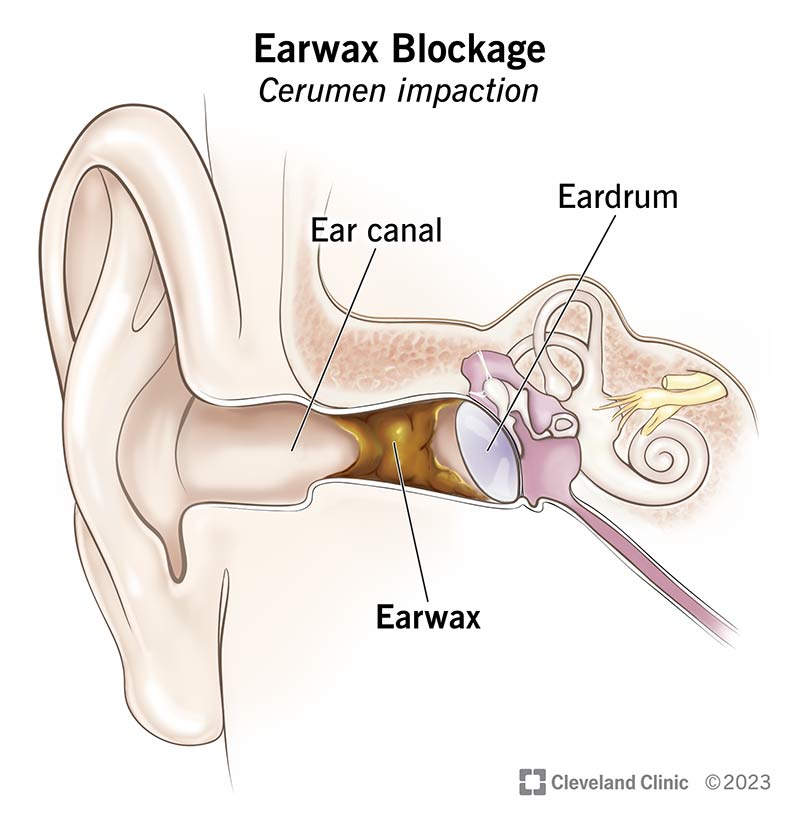Untreated earwax buildup can lead to hearing loss, irritation, pain in your ear, dizziness, ringing in your ears and other issues. In most cases, earwax impaction isn’t dangerous and symptoms go away with treatment. Earwax blockage treatments include drops to soften the wax or manual removal at your healthcare provider’s office.
Advertisement
Cleveland Clinic is a non-profit academic medical center. Advertising on our site helps support our mission. We do not endorse non-Cleveland Clinic products or services. Policy

“Cerumen impaction” is the medical term for earwax blockage. Earwax (cerumen) plays an important role in ear health. It cleans your ears and protects them from dust, dirt and infection.
Advertisement
Cleveland Clinic is a non-profit academic medical center. Advertising on our site helps support our mission. We do not endorse non-Cleveland Clinic products or services. Policy
Despite its many benefits, earwax can cause issues if too much of it builds up. Cerumen impaction may result in ear pain, itchiness, ringing in your ears, hearing loss or other issues. When necessary, a healthcare provider can help you with earwax removal.
Earwax blockage can happen to anyone. About 10% of children and 5% of adults have it.
Impacted cerumen is more likely to occur in people who:
Impacted earwax symptoms may include:
Some people get earwax buildup simply because they naturally produce more earwax.
You can also get earwax impaction if:
Advertisement
If left untreated, excessive earwax may cause earwax impaction symptoms to worsen. These symptoms might include hearing loss, ear irritation, tinnitus and other issues. A buildup of earwax might also make it difficult to see into your ear, which may result in potential issues going undiagnosed.
Your healthcare provider will perform a physical examination. During this visit, they’ll look into your ears with a special instrument, called an otoscope, to see if earwax buildup is present.
Impacted cerumen treatments involve both at-home and in-office methods, including:
Talk to your healthcare provider before trying any treatment.
Clean the outside of your ear with a washcloth. After showering or bathing, dry your ears as much as possible.
You should never, under any circumstances, put anything inside your ear canal — including cotton swabs. Not only can using cotton swabs damage your eardrum, but it can also encourage your ears to make more earwax. (Learn more about why you should avoid cotton swabs in “Additional Common Questions” below.)
You can use cerumenolytic solutions (solutions to dissolve wax) in your ear canal. These solutions include:
With these solutions, you put a few drops into the affected ear and lie on the opposite side. This way, the solution can drip into your affected ear. These oils should be used sparingly. If using an over-the-counter earwax removal, follow the directions provided.
Another option is irrigating or syringing your ear. This involves using a syringe to rinse out your ear canal with water or saline solution. Generally, you should soften the wax first by using a cerumenolytic solution. Then, you’ll gently irrigate your ear with a bulb syringe.
Finally, your healthcare provider can remove earwax manually using special instruments. They might use a cerumen spoon, forceps, irrigation or a suction device. Generally, these procedures only take a few minutes to complete.
Though impacted cerumen is annoying and inconvenient, it usually isn’t dangerous. Still, you should call a healthcare provider if you notice impacted earwax symptoms like ear pain, dizziness or hearing loss.
Some people produce more earwax than other people and may need routine treatments to remove it. Talk to your provider about ways to soften earwax and keep your ears healthy.
Advertisement
Don’t stick anything into your ears to clean them. If you use cotton swabs, you should only use them on the outer part of your ear. If a healthcare provider has to remove earwax from your ears more than once a year, ask them what they suggest to stop earwax from building up.
Call a healthcare provider if you develop cerumen impaction symptoms such as ear pain, itchiness, tinnitus, dizziness, hearing loss or a feeling of fullness in your ears.
You should seek medical care immediately if you have:
Your healthcare provider can tell you how to get rid of earwax buildup. Here are a few questions you may want to ask:
Many people use cotton swabs to clean their ears. But research shows that cotton swabs can actually cause more earwax production. This is because cotton swabs stimulate the tiny hairs inside your ear canal. When you stimulate these hairs, they send messages to the glands inside your ear canal to make more earwax.
Advertisement
Don’t use suction devices for home use (such as Wax-Vac®). They aren’t effective for most people and most healthcare providers don’t recommend them.
Ear candles, advertised as a natural method to remove earwax, are ineffective. They can also cause injuries such as burns to your external ear and ear canal. They may even perforate (tear) your eardrum.
Remember, earwax on its own isn’t bad. It cleans your ears and keeps them from getting infected. However, if earwax builds up, it can cause issues like irritation, itchiness and hearing loss. It’s only safe to clean the outside of your ears and to use drops or water to soften earwax. You should always contact your healthcare provider to remove earwax using an instrument.
Advertisement
If you have conditions affecting your ears, nose and throat, you want experts you can trust. Cleveland Clinic’s otolaryngology specialists can help.

Last reviewed on 01/13/2023.
Learn more about the Health Library and our editorial process.